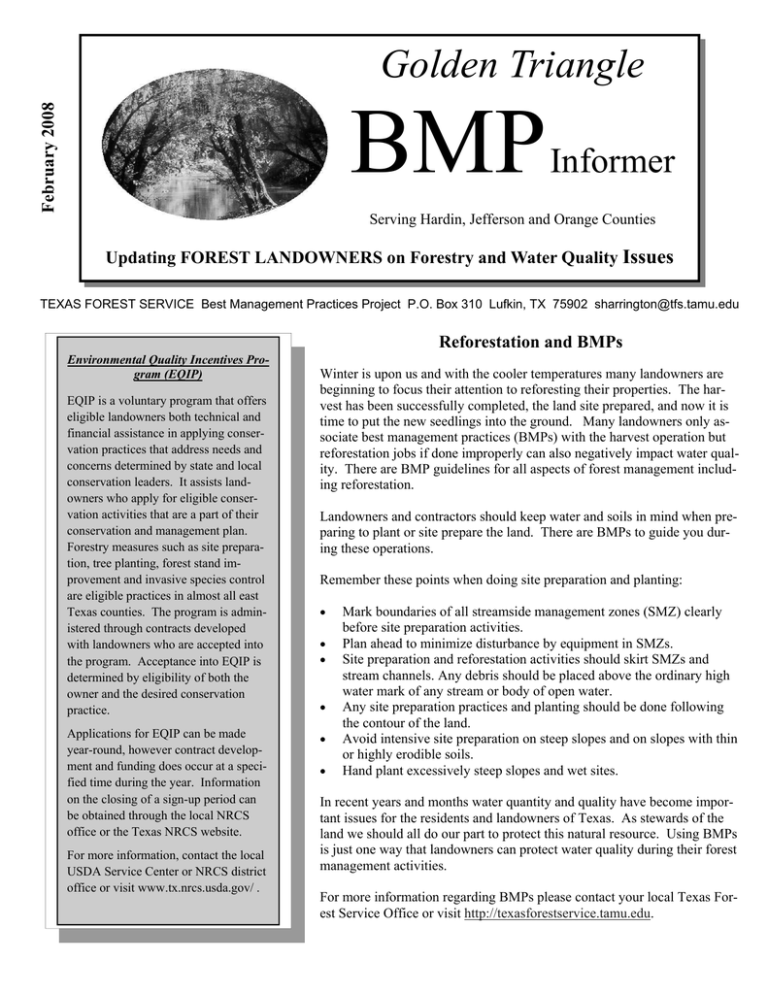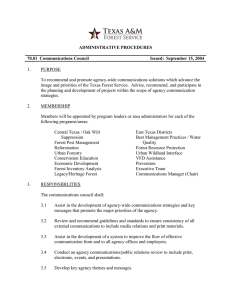BMP Golden Triangle Informer
advertisement

February 2008 Golden Triangle BMP Informer Serving Hardin, Jefferson and Orange Counties Updating FOREST LANDOWNERS on Forestry and Water Quality Issues TEXAS FOREST SERVICE Best Management Practices Project P.O. Box 310 Lufkin, TX 75902 sharrington@tfs.tamu.edu Reforestation and BMPs Environmental Quality Incentives Program (EQIP) EQIP is a voluntary program that offers eligible landowners both technical and financial assistance in applying conservation practices that address needs and concerns determined by state and local conservation leaders. It assists landowners who apply for eligible conservation activities that are a part of their conservation and management plan. Forestry measures such as site preparation, tree planting, forest stand improvement and invasive species control are eligible practices in almost all east Texas counties. The program is administered through contracts developed with landowners who are accepted into the program. Acceptance into EQIP is determined by eligibility of both the owner and the desired conservation practice. Applications for EQIP can be made year-round, however contract development and funding does occur at a specified time during the year. Information on the closing of a sign-up period can be obtained through the local NRCS office or the Texas NRCS website. For more information, contact the local USDA Service Center or NRCS district office or visit www.tx.nrcs.usda.gov/ . Winter is upon us and with the cooler temperatures many landowners are beginning to focus their attention to reforesting their properties. The harvest has been successfully completed, the land site prepared, and now it is time to put the new seedlings into the ground. Many landowners only associate best management practices (BMPs) with the harvest operation but reforestation jobs if done improperly can also negatively impact water quality. There are BMP guidelines for all aspects of forest management including reforestation. Landowners and contractors should keep water and soils in mind when preparing to plant or site prepare the land. There are BMPs to guide you during these operations. Remember these points when doing site preparation and planting: • • • • • • Mark boundaries of all streamside management zones (SMZ) clearly before site preparation activities. Plan ahead to minimize disturbance by equipment in SMZs. Site preparation and reforestation activities should skirt SMZs and stream channels. Any debris should be placed above the ordinary high water mark of any stream or body of open water. Any site preparation practices and planting should be done following the contour of the land. Avoid intensive site preparation on steep slopes and on slopes with thin or highly erodible soils. Hand plant excessively steep slopes and wet sites. In recent years and months water quantity and quality have become important issues for the residents and landowners of Texas. As stewards of the land we should all do our part to protect this natural resource. Using BMPs is just one way that landowners can protect water quality during their forest management activities. For more information regarding BMPs please contact your local Texas Forest Service Office or visit http://texasforestservice.tamu.edu. Texas Forest Service Management Considerations for Wildlife Each wildlife species has unique habitat requirements, so start by learning more about the species that interest you most. The following practices are aimed at producing wildlife diversity: • Provide more edge habitat by creating a patchwork of small stands harvested at different times. Favor wildlife that use the interior of large forest areas by making large clearcuts. Improving My Land Stream Crossings Two types of stream crossings that minimize stream sedimentation and provide dependable access are culverts and geoweb. When sized to proper length and diameter for the stream drainage area, culverts can provide excellent access across streams (see left column). Different types and sizes are available for various needs, ranging from 18-inch diameter galvanized steel to 10-foot diameter tank cars. • When clearcutting, leave scattered live trees with narrow crowns to provide more vertical habitat. (Kill these trees before they begin to suppress the reproduction.) • Leave corridors of standing trees through large clearcuts to provide cover for wildlife that need to cross over them. • Thin sapling and pole stands more heavily than necessary for timber production to provide more sunlight and thus stimulate growth of vegetation near the forest floor. • Retain live trees with cavities for squirrels, raccoons, and other cavity dwellers. • When thinning or harvesting stands, leave or create dead standing trees (snags). They provide insects and nesting cavities for birds. • Favor tree and shrub species that produce edible seeds, berries or fruits (e.g., oak, black cherry, hickories, dogwood, etc.). Thin oak stands regularly to encourage acorn production. Plant fruit-bearing trees in openings. Seed log landings and skid trails with grass and clover. For added diversity and winter cover, plant or encourage scattered groups of slowgrowing conifers such as red cedar. Geoweb can provide a permanent low-water crossing or ford that minimizes stream sedimentation. The plastic material forms a honeycomb-shaped mat that is filled with soil or gravel to form a solid road base. Best used in crossings with flat approaches to the stream, properly installed geoweb allows permanent access across a stream, even for a fully- Golden Triangle BMP Informer New Stream Crossing Workshop A Success Texas Forest Service in 2007 began offering a new BMP workshop focusing on stream crossings to logging professionals as part of the Pro-Logger program. This course is approved for 6.0 hours of continuing education, meeting the annual requirements for logging contractors to maintain their certification. To date, Texas Forest Service has conducted five workshops, training over 150 people. “The response we have seen from logging professionals in East Texas has been tremendous” said Shane Harrington, BMP Forester, Texas Forest Service. “We’ve even had other states contact us about using our workshop as a model for their own states” said Harrington. Future dates for additional stream crossing workshops are being planned now for 2008. This new workshop is designed like the traditional BMP course in which attendees spend the morning session participating in discussions, watching videos, and listening to slide presentations. After lunch, the class travels to several field sites to apply the principles that were presented earlier that morning. Topics covered in this workshop include: How to plan a stream crossing Advantages and disadvantages of various stream crossing methods Proper installation and remediation of stream crossings The idea to develop this course came after the release of the 2005 Texas BMP Implementation Monitoring report, a document produced to determine the extent to which the forestry community is voluntarily following the recommended guidelines. The report showed that stream crossings consistently ranked lower than any other category evaluated, which is a concern, given the sensitivity of these areas. “Implementing BMPs on stream crossings is absolutely critical because these locations are direct contact points to the stream. Improperly constructing a stream crossing can have a negative impact on water quality,” said Hughes Simpson, Texas BMP Coordinator. Participants have seen the benefits in attending this course. Post workshop evaluations have shown that 97% of attendees would recommend this class to others, noting that the course material was explained very well. The evaluations also showed significant interest in attending other BMP related workshops, such as courses on forest roads and streamside management zones, offered by Texas Forest Service. Typical written comments from participants were: I think this was a good workshop and everyone that works on dirt needs to attend. Good. The men did a great job of showing different ideas about future logging procedures. Thanks for your effort. The class is needed to try to get everyone on the same page! Good. Great opportunity to expand knowledge. To register for this workshop or any other course required for the Pro-Logger certification, contact the Texas Forestry Association at (936) 632-8733. For more information on Best Management Practices, please contact the Texas Forest Service at (936) 639-8180 or go online at http://texasforestservice.tamu.edu. Distribution of the Golden Triangle BMP Informer is provided free of charge to forest landowners of Hardin, Jefferson and Orange Counties. Funding has been provided through cooperation of the Environmental Protection Agency (EPA), the Texas State Soil and Water Conservation Board (TSSWCB) and the Texas Forest Service (TFS). PLEASE ADVISE US IF YOU WISH FOR YOUR NAME TO BE REMOVED FROM OUR MAILING LIST. The Texas Forest Service is an Affirmative Action/Equal Opportunity Employer committed to Excellence Through Diversity. P. O. Box 310 Lufkin, TX 75902-0312 Websites of Interest Texas Forest Service - http://texasforestservice.tamu.edu Texas Tree Planting Guide - http://texastreeplanting.tamu.edu/ Texas Wildlife Fact Sheets – http://www.tpwd.state.tx.us/huntwild/wild/species/ Preparing a Community Wildfire Protection Plan – A Handbook for Wildland-Urban Interface Communities http://www.safnet.org/policyandpress/cwpphandbook.pdf Common Hardwood Tree Diseases – Prevention and Control – http://forestry.about.com/od/forestdiseases/p/ dis_com_hwd.htm State of Texas Threatened and Endangered Species Regulations – http://www.tpwd.state.tx.us/huntwild/wild/species/endang/regulations/texas/index.phtml
